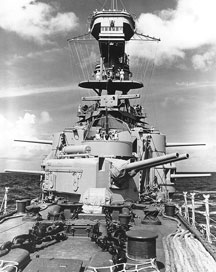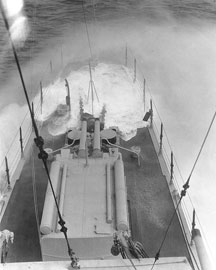U.S. Navy Plan Gold:
Alternatives
to Omaha
By Mike Bennighof, Ph.D.
January 2018
 With Europe engulfed in war, in the fall
of 1915 the U.S. Navy’s General Board
sat down to plan a huge build-up of the American
battle fleet. A five-year plan, later shortened
to three (funded in the 1917 through 1919
fiscal years), was to give the United States
a fleet at least on par with that of Great
Britain, one able to take on the winner of
the European war on an equal footing. With
Japan also seen as a looming threat, a major
construction program was seen as vital to
protect American interests. With Europe engulfed in war, in the fall
of 1915 the U.S. Navy’s General Board
sat down to plan a huge build-up of the American
battle fleet. A five-year plan, later shortened
to three (funded in the 1917 through 1919
fiscal years), was to give the United States
a fleet at least on par with that of Great
Britain, one able to take on the winner of
the European war on an equal footing. With
Japan also seen as a looming threat, a major
construction program was seen as vital to
protect American interests.

Don’t worry. Plan Gold has
these, too: An early American battle cruiser
concept.
At the heart of the program lay six huge
battleships of the South Dakota class,
enormously larger than the preceding Colorado class authorized for the 1916 fiscal year.
There would also be six very large but lightly-armored
battle cruisers. And to scout for the battle
fleet, 10 cruisers of what would become the Omaha class were ordered in the 1917
program.

The bizarre forward armament of the Omaha-class USS Memphis.
|
The General Board wanted a very fast cruiser,
capable of over 30 knots, with very high endurance
and an armament of at least six six-inch guns,
all on a displacement of 8,000 tons. Reports
from Europe indicated that even higher speed
was essential for a scout cruiser, and so
the speed requirement went to 35 knots (a
figure shared with the “flush deck”
destroyers of the 1916 program and the battle
cruisers). The cruiser would also have to
carry a floatplane.
The Board demanded an emphasis on end-on
fire, a concept abandoned by foreign navies
a decade earlier. Scouts, the Americans believed,
would rarely fight in line-ahead formation
but instead would be advancing toward or fleeing
from the enemy. And so the designers adopted
a very retrograde “citadel” arrangement,
with a turret for two guns forward, and two
pairs of six-inch guns mounted behind it in
casemates, one pair over the other. An identical
arrangement faced aft. Theoretically this
gave the ship a forward- or aft-firing battery
of six guns, but in practice American crews
found the lower guns so wet in any sort of
sea that they became unusable.
Two of the cruisers were laid down in December
1918, and eight more during 1920. Even before
riveting began, the General Board became dissatisfied
with the design. Study of British cruisers
during the American deployment with the Grand
Fleet had exposed the end-on concept as outdated,
and the design was already recognized as badly
overweight. In October 1920, the Bureau of
Construction and Repair (responsible for ship
design) recommended halting the eight ships
just begun and re-casting the design to eliminate
the casemates and mount eight six-inch guns
in twin turrets. Sensing that Congress might
eliminate the ships altogether if their construction
stopped, the General Board rejected the redesign
proposal and ordered the ships to proceed
as designed. From their perspective this was
probably a wise choice — with the Great
War over, funding problems halted the construction
of several ships at times even without massive
design changes.

Why they were thought overloaded: USS Milwaukee takes water during
a storm off Hong Kong, 1929.
|
The Omaha derivative with four turrets
was proposed, however, as the follow-on to the Omaha class. The Navy believed it needed
large numbers of scout cruisers (they would
not be known as “light cruisers”
until 1930) to screen the battle fleet, lead
detroyer flotillas, protect lines of communications
and, of course, to scout. The Omaha derivative
could be put into production quickly if approved,
and its hull form (the Omahas were excellent
seaboats) and high speed had pleased the Navy.
But the General Board became obsessed with the
British Hawkins class cruisers mounting
7.5-inch guns, even as the Royal Navy came to
consider them a costly mistake and reverted
to the 6-inch gun as their standard. The new
American scout cruisers would have to carry
8-inch guns to overpower the Hawkins, and
this would require greater size that the Omaha hull could not deliver. The new, larger cruiser
with 8-inch guns became the Pensacola class; its specifications were those the American
delegates proposed in the Washington Naval Limitations
talks and would be the basis of the “Treaty
Cruiser” type.
Another Omaha variant was proposed
very early in the design stages. The battle
cruiser designs grew out of a requirement
to back scouting forces with heavy firepower;
where British battle cruisers were enlarged
armored cruisers and German ones actually
fast battleships, American battle cruisers
would have been massively overgrown scout
cruisers, with little to no armor. Most of
the American “battle scout” proposals
were large ships, growing in size over several
years from 10,000-ton vessels with 6-inch
guns through 25,000-ton ships with 10-inch
guns (seen in U.S. Navy Plan Red) to 43,500-ton monsters
with 16-inch guns.
 
But in February 1916, the General Board requested
a design for an Omaha (then still known
as the “1917 Scout”) mounting
two 14-inch guns in single turrets. The Bureau
of Construction and Repair duly submitted
a sketch, noted as Design 160. Proposals for
cruiser-sized hulls with battleship-sized
weapons would continue for the next two decades,
but the Navy’s engineers rightly noted
some severe problems with the approach. A
battleship’s armored turret is mounted
atop a heavy, armored barbette that sinks
down into the bowels of the ship, structurally
resting on the keel. While the armor protects
the magazines and turntables, it also adds
greatly to the ship’s structural integrity.
The Omaha with heavy guns would lack
this, and its lightly-built hull would be
gravely stressed by the blast effect of firing
its big guns. With only two barrels, the ship’s
rate of fire would be abysmally low and it
could easily be overwhelmed by an opponent
armed with lighter but more faster-firing
guns. Such a ship could be built, but the
engineers considered it a bad idea and eventually
the Board concurred. Design 160 was tabled.
Game designers, of course, are not constrained
by the same bounds of reality as the Navy’s
General Board. U.S.
Navy Plan Gold includes both
of these cruiser alternatives. They’re
listed with CS (scout cruiser) hull numbers,
to avoid re-using numbers in the American
cruiser numbering sequence, or assigning ridiculously
high hull numbers.
If you want to play with
the Omaha alternatives, you can order Plan Gold here.
Mike Bennighof is president of Avalanche Press and holds a doctorate in history from Emory University. A Fulbright Scholar and award-winning journalist, he has published over 100 books, games and articles on historical subjects.
He lives in Birmingham, Alabama with his wife, three children and his dog, Leopold.
|
